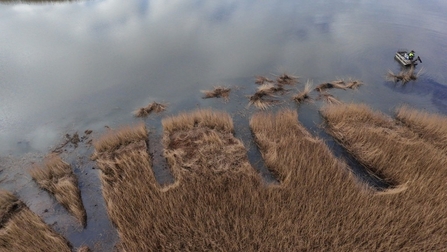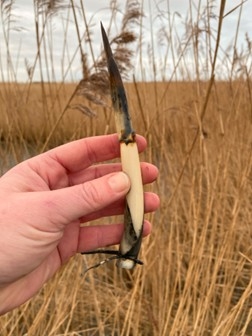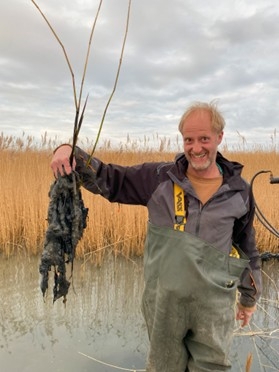Recent visitors to East Chevington Nature Reserve may have heard a strange rumblings from deep within the reedbeds. No, it’s not the booming call of an overwintering bittern, but the sound of Derrick Emms and his trusty reedcutting Truxor machine, affectionally named ‘Gertrude’.
Reed Cutting at East Chevington
Reedbed at East Chevington. Image by Graham Holyoak.
As part of the Northumberland Wildlife Trust’s Biodiversity Boost Project, Derrick from The Sustainable Water Company will be cutting channels within the reed on the reserve’s south pool to restructure the reedbed, making it a more suitable habitat for bitterns as well as a host of other species that live, feed and breed in this habitat. The work being completed will increase the surface area of reed at the water’s edge and create a varied age structure of reed to encourage greater biodiversity.

The extensive reedbeds at East Chevington (photo by Helen Walsh)
Reedbeds are a transitional habitat existing between land and water, which historically have reduced in area due to change in land use for agriculture and large scale drainage schemes. Today, the quality of reedbeds are often affected by pollution by agricultural run-off. The reedbeds at East Chevington are some of the largest in Northumberland and were planted after the restoration of the East Chevington Opencast Coal site which closed in 1994.

Channels cut in the reedbeds by ‘Gertrude’ the Truxor. (photo by Helen Walsh)
In addition to cutting channels in the reed, the Truxor is able to remove the reed by its rhizomes and we hope to successfully translocate some of these reeds to the north pool, creating bunds to reduce the wave action on the lake and further increasing the area of reed there.

The rhizomes that will be transplanted in the north pool (photo by Helen Walsh)
Though the winter weather may not seem ideal for practical conservation work outdoors on the water, this project has been carefully planned to minimise disruption to the resident population of marsh harriers which at this time of year only use the reeds to roost overnight.

Derrick Emms with some cut reed (photo by Helen Walsh)
Derrick commented, “It’s phenomenal to see how quickly we can regenerate an environment and get it back to something that resembles nature. It proves to me that we can repair what damage we’ve done”
The Biodiversity Boost Project is made possible by a grant from the Species Survival Fund, in partnership with Defra and the National Lottery Heritage Fund.

